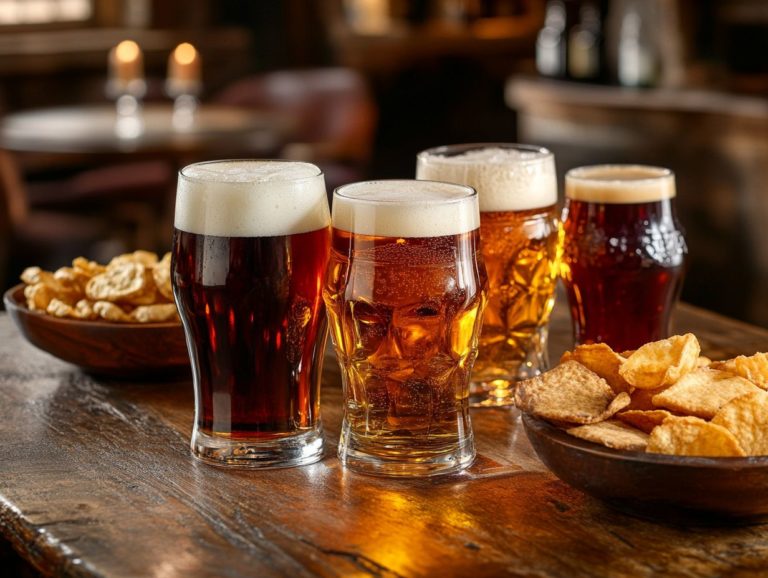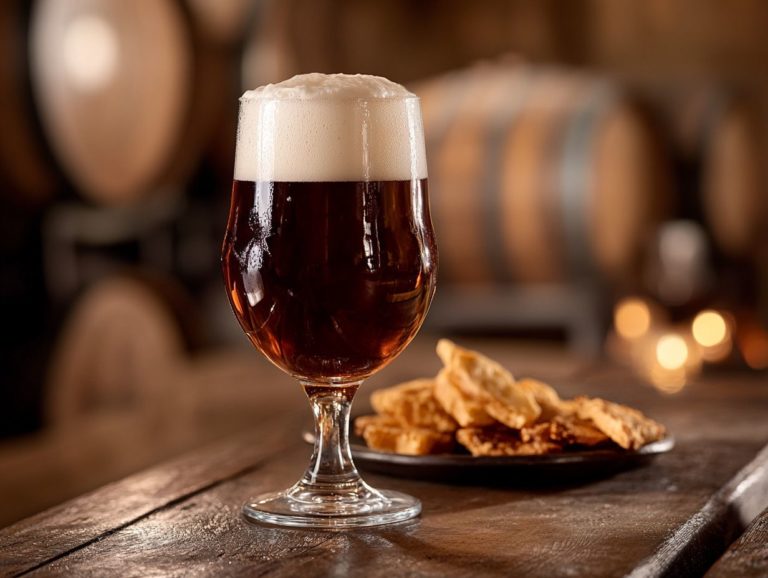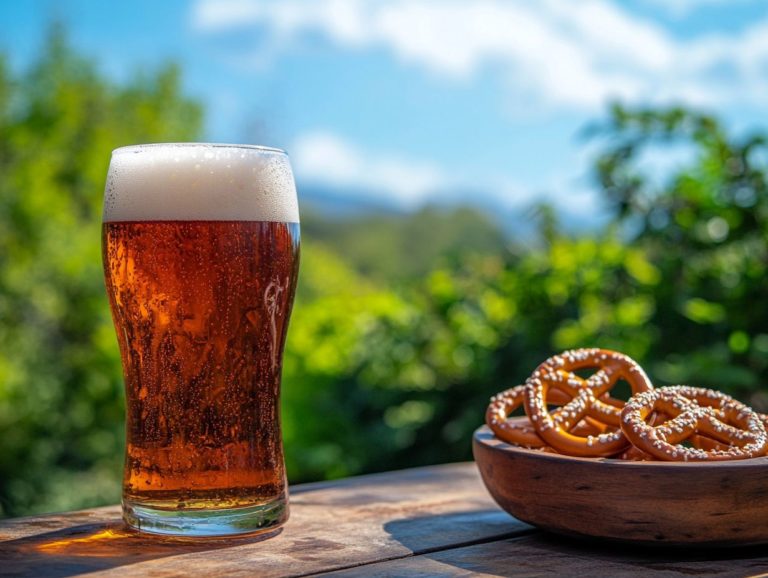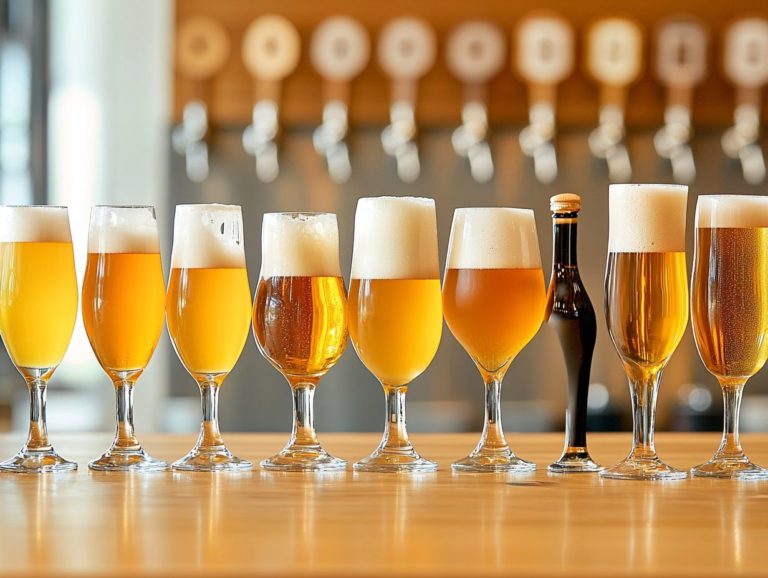Why You Should Try a Barleywine
Barleywine is a unique and robust beer style, often considered a strong beer, that you ll find increasingly captivating. This is especially true if you consider yourself a craft beer enthusiast and enjoy exploring different beer styles.
Renowned for its high alcohol content and rich flavors, this beverage presents several variations, each promising a distinct tasting journey. From its intriguing flavors developed from aging in barrels to its potential health benefits, barleywine transcends mere refreshment; it embodies a celebration of impeccable craftsmanship and brewing traditions.
This article delves into the various types of barleywine, offers insights on how to savor it, and guides you on where to discover this delightful brew. Grab a glass and dive into the world of barleywine! Whether you prefer American Barleywine, English Barleywine, or lesser-known styles like Wheatwine and Rye Barleywine, there’s a flavor profile for every palate.
Contents
Key Takeaways:
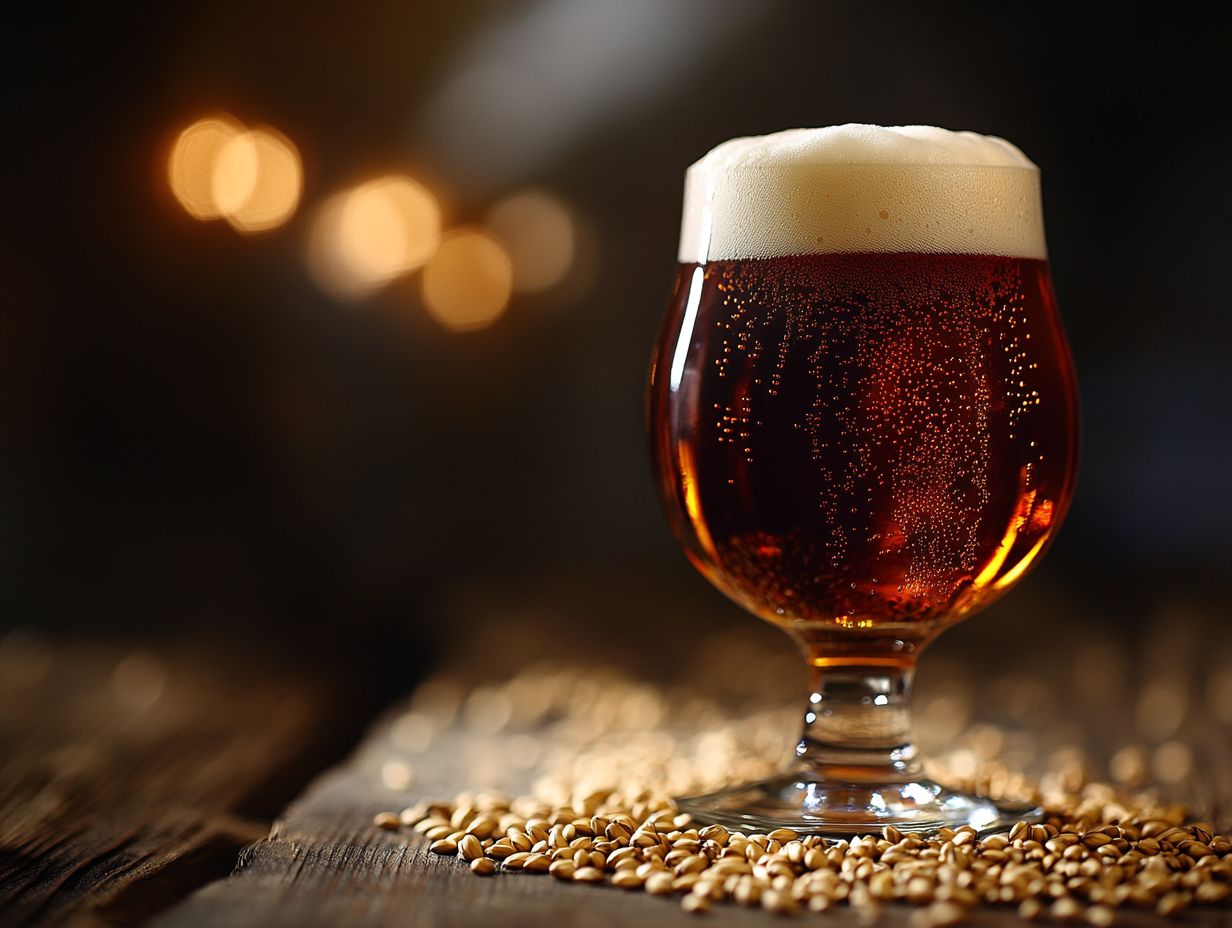
- Barleywine is a strong, flavorful beer that comes in different types such as American, English, wheat, and rye, each offering unique malt characteristics and brewing techniques.
- Drinking barleywine may offer health benefits such as providing nutrients, preventing heart disease, and improving bone health, but it should be consumed in moderation.
- To fully enjoy barleywine, pair it with food, serve it at the right temperature, use the proper glassware, and consider aging for added complexity. Explore different breweries’ limited releases too!
What Is Barleywine?
Barleywine is a rich and complex beer style that has captured the hearts of beer enthusiasts and beer reviewers for centuries, thanks to its high alcohol content and intricate flavor profiles. Hailing from Great Britain, this strong ale is brewed with an abundance of malt, which imparts delightful sweet malt characteristics and a robust body.
As craft beer trends continue to evolve, barleywine is experiencing a renaissance among breweries. Each brewery showcases unique brewing techniques and time-honored traditions. Whether it s barrel-aged versions that emphasize flavors developed from aging in barrels or modern takes that celebrate hoppy flavors, barleywine stands as a significant chapter in the world of beer, embodying its enduring legacy in beer culture. Renowned brewers like Sierra Nevada, Central City, and Fuller’s demonstrate the diverse interpretations of barleywine through their expertly crafted brews.
What Are The Different Types Of Barleywine?
Barleywine can be classified into several distinct types, each presenting unique characteristics and flavor experiences that establish it as one of the most versatile and intriguing beer styles available today. These include American Barleywine, English Barleywine, Wheatwine, and Rye Barleywine.
The two primary styles, American Barleywine and English Barleywine, showcase a range of alcohol by volume and flavor profiles. This invites you to explore the differences, especially in their malt characteristics and hop profiles.
Wheatwine and Rye Barleywine each offer unique malt characteristics and hoppy aromas. These variations cater to a diverse array of preferences in the realm of craft beer, ensuring there s something for everyone to enjoy. The brewing process for these sub-styles often involves unique techniques and ingredients, adding to their distinctive profiles.
1. American Barleywine
American Barleywine is a bold and assertive beer style that you re sure to appreciate. It is known for its high alcohol content, hoppy flavors, and intense bitterness that sets it distinctly apart from its English counterpart.
This style has become a favorite among many brewers for its capacity to showcase bold flavors and innovative brewing techniques. Its uniqueness arises from a meticulous balance of malt flavors that supports its robust character.
American Barleywine offers layers of caramel, toffee, and dark fruit notes that harmoniously complement the hop profile. The hop character in American Barleywines is typically intense, showcasing citrusy, piney, or resinous qualities that embody the innovative spirit of today s craft breweries.
Notable examples like Sierra Nevada’s Bigfoot Barleywine and Central City’s Red Racer illustrate the complexity of this style. They capture the prevailing trends in craft beer and emphasize bold flavors and high alcohol by volume.
This has become a hallmark of the American craft beer movement, inviting you to indulge in a truly remarkable tasting experience!
2. English Barleywine
English Barleywine offers a more refined experience compared to its American counterpart. It focuses on rich malt characteristics and a beautifully complex balance of flavors.
You will discover delightful nuances of toffee and caramel that elevate your drinking experience. This style is often featured in beer reviews for its elegant malt sweetness and age-worthy qualities.
English Barleywine allows the sweetness of the malt to shine, resulting in a decadent mouthfeel that is both warming and satisfying. With its lower hop bitterness, the malt-driven sweetness takes center stage.
Exceptional examples come from esteemed breweries like Fuller’s and Sierra Nevada, both of which have perfected the art of crafting this style. These brews are frequently celebrated for their layers of dried fruit, including raisins and figs, which add to the overall depth of flavor.
Enthusiasts like you will appreciate the seamless integration of these flavors, making English Barleywine an ideal choice for cozy evenings and special occasions.
3. Wheatwine
Wheatwine offers a delightful twist on the classic barleywine style. It features a substantial amount of wheat that bestows a smooth mouthfeel and a uniquely sweet malt profile.
This style is a testament to innovation within the craft beer movement, highlighting the diversity in the barleywine category. The incorporation of wheat enhances the beer s creaminess and introduces delightful notes of biscuit and bread.
As you explore the brewing process, you ll find that the addition of white wheat or specialty malts unveils subtle fruity esters and a hint of spiciness. This distinguishes it from its barleywine counterparts.
Renowned breweries such as Boulevard Brewing Co. and New Holland Brewing have skillfully crafted exceptional examples of Wheatwine, highlighting its rich characteristics. When comparing Wheatwines to traditional barleywines, you ll notice they typically feature a lighter body and carbonation.
This makes them an intriguing choice for anyone who appreciates a nuanced take on this robust ale style.
4. Rye Barleywine
Rye Barleywine is an intriguing sub-style that introduces rye malt into the brewing process. It offers spicy notes and a remarkable complexity that sets it apart from traditional barleywines.
This unique grain adds layers of flavor, giving each sip a profound depth often marked by a peppery bite and a subtle earthiness. The inclusion of rye elevates the aromatic profile and enhances the mouthfeel.
This results in a rich, somewhat creamy texture that invites you to savor each drop. Breweries such as Dogfish Head and Boulevard Brewery have artfully crafted their interpretations, demonstrating rye’s versatility in producing a balanced yet bold brew.
The finest examples beautifully showcase the interplay between the malt’s sweetness and the rye’s spiciness. They transform each beer into an intriguing journey for your palate!
What Are The Characteristics Of Barleywine?
Barleywine stands out with several defining features that endear it to beer enthusiasts. Its high alcohol content, strong malt flavor, hoppy aroma, and often darker hue all hint at its rich and complex nature. The brewing process includes specialized techniques to achieve these characteristics, making it a standout among fermented beers.
Typically, this style of beer has an alcohol by volume ranging from 8% to 12%, promising an intense drinking experience. The prominent malt characteristics deliver a sweetness that beautifully balances the hop bitterness, creating a perfect harmony of flavors that resonates with a diverse array of palates.
1. High Alcohol Content
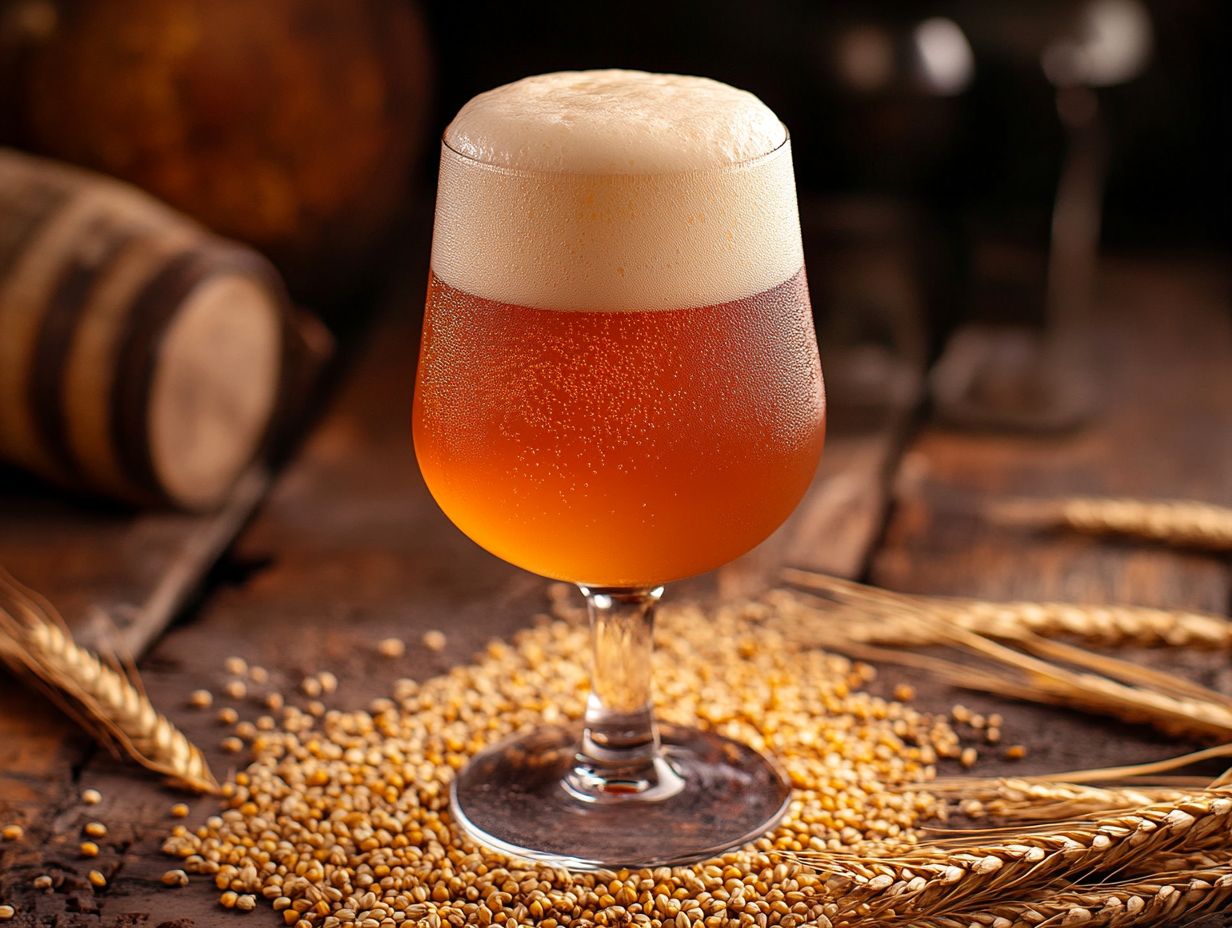
One of the most defining characteristics of barleywine is its impressively high alcohol content, typically ranging from 8% to 12% alcohol by volume. This sets it apart as one of the strongest beer styles on the market and contributes to its reputation as an age-worthy beer, often improving with time.
This strength affects the beer’s flavor and shapes your drinking experience. The elevated alcohol level enhances the rich and complex malt flavors, revealing enticing notes of caramel, toffee, and dark fruits. It also adds to the beer’s body and mouthfeel. When enjoyed responsibly, this potent brew provides a memorable drinking experience akin to that of fine liquors.
Brewing techniques such as extended mashing and the use of specialty malts are crucial in achieving this heightened alcohol content. These techniques enable brewers to extract maximum fermentable sugars. This strength calls for a more moderate approach to consumption; savoring a barleywine becomes a nuanced experience, allowing you to uncover layers of flavor over time. It s truly best suited for leisurely sipping, rather than casual drinking. The age-worthiness of certain barleywines makes them a special addition to any beer selection.
When enjoyed responsibly, barleywine takes you on a rich journey through bold tastes, providing an engaging and memorable drinking experience.
2. Strong Malt Flavor
Barleywine is celebrated for its robust malt flavor, which lends a rich sweetness and complexity to the brew. It often showcases delightful notes of caramel, toffee, and dark fruit. This rich malt profile finds comparisons with high-end beverages like Moscato or White Zinfandel for its lush, sweet characteristics.
The choice of malt is crucial in defining the overall character of this cherished ale. It shapes the core sweetness and influences additional nuances such as nuttiness, chocolate, and even a hint of spice. For example, incorporating Munich malt amplifies the toasty qualities, while Crystal malts contribute layers of caramel sweetness that enrich the mouthfeel. A judicious touch of roasted malts might introduce a subtle bitterness that balances the sweetness, creating an intricate interplay of flavors that aficionados adore.
Ultimately, the thoughtful blending of these malts gives brewers the power to craft a barleywine that is not only irresistibly sweet but also profoundly satisfying and remarkably complex. This careful curation results in a bitter sweetness that truly defines the essence of barleywine.
3. Hoppy Aroma
Despite the strong malt presence, you ll notice that barleywine also boasts a prominent hoppy aroma. This can vary significantly depending on the brewing methods and styles, especially in American Barleywines and English Barleywines. This characteristic beautifully highlights the delicate balance between the sweetness of the malt and the bitterness imparted by hops, creating a rich tapestry of flavors and aromas.
Hops like Cascade, Centennial, and Amarillo are often used to elevate the beer’s profile, adding not just bitterness but also delightful citrus, floral, and piney notes. For example, an American Barleywine might lean heavily on these aromatic varieties, delivering a bold, vibrant hop character that playfully counters the intense malt sweetness. This aligns with predictions in the craft beer predictions community about the rising popularity of hop-forward barleywines.
In contrast, English styles tend to incorporate traditional varieties like East Kent Goldings or Fuggles, resulting in a more subdued, earthy hop contribution. This harmonizes beautifully with the caramel and toffee notes typical of their malt base. Thus, the careful selection of hops becomes essential in crafting a well-rounded barleywine that appeals to a diverse range of palates.
4. Darker Color
Barleywines typically display a captivating range of colors, from amber to deep brown. This serves as a visual testament to their rich malt content and intricate flavor profile.
The depth of color in these exceptional brews is profoundly influenced by the choice and combination of malts selected during the brewing process. For instance, when brewers opt for darker malts like crystal and roasted varieties, they not only enhance the beer s hue but also introduce layers of complex flavors. You ll find enticing notes of caramel, toffee, and even dark fruit dancing on your palate.
The rich colors not only captivate but also enhance your enjoyment with every sip! When served, these rich colors ignite anticipation and showcase the craftsmanship behind the brew, inviting you to delve into the nuanced profiles that await with every sip.
What Are The Benefits Of Drinking Barleywine?
Drinking barleywine in moderation presents a range of potential benefits, making it an exceptional choice for those who relish strong beers while maintaining a mindful approach to their health.
Rich in nutrients thanks to its malt content, barleywine has been associated with various health advantages. Research suggests that moderate consumption may contribute to heart disease prevention, lower cholesterol levels, and even enhance bone health. The brewing yeasts in barleywine contribute to its nutritional profile as well.
This unique blend of enjoyment and potential wellness benefits positions barleywine as a beer style worthy of responsible appreciation.
1. Rich In Nutrients
Barleywine stands out as a nutrient-rich beverage, largely due to its high malt content. This imparts a variety of vitamins and minerals that can be advantageous when enjoyed in moderation.
This exceptional brew is particularly remarkable for its B vitamins, which are essential for energy production and metabolism. These include riboflavin, niacin, and vitamin B6. Additionally, barleywine boasts essential minerals such as magnesium, potassium, and phosphorus, which are vital for maintaining overall health.
These nutrients, derived from the malted barley, support numerous bodily functions, including muscle and nerve function as well as bone health. While indulging excessively can overshadow these benefits, savoring barleywine in moderation allows you to fully appreciate its rich flavors while reaping the potential health rewards associated with its impressive nutrient profile.
This also highlights its place in beer history as one of the most age-worthy beers.
2. May Help Prevent Heart Disease
3. Beer Recommendations and Liquor Similarities
Recent research suggests that enjoying moderate amounts of barleywine may help prevent heart disease. Certain compounds in beer can enhance cardiovascular health.
This benefit largely stems from the presence of antioxidants like polyphenols, which improve blood circulation and reduce inflammation. Studies have shown that these compounds can lower LDL cholesterol levels and enhance the health of the inner lining of blood vessels both essential for maintaining a healthy heart.
By savoring barleywine in moderation, you can potentially boost your levels of high-density lipoprotein (HDL) cholesterol, often dubbed good cholesterol. Thoughtfully incorporating barleywine into your diet could serve as a delightful addition to your heart health strategy.
4. May Help Lower Cholesterol
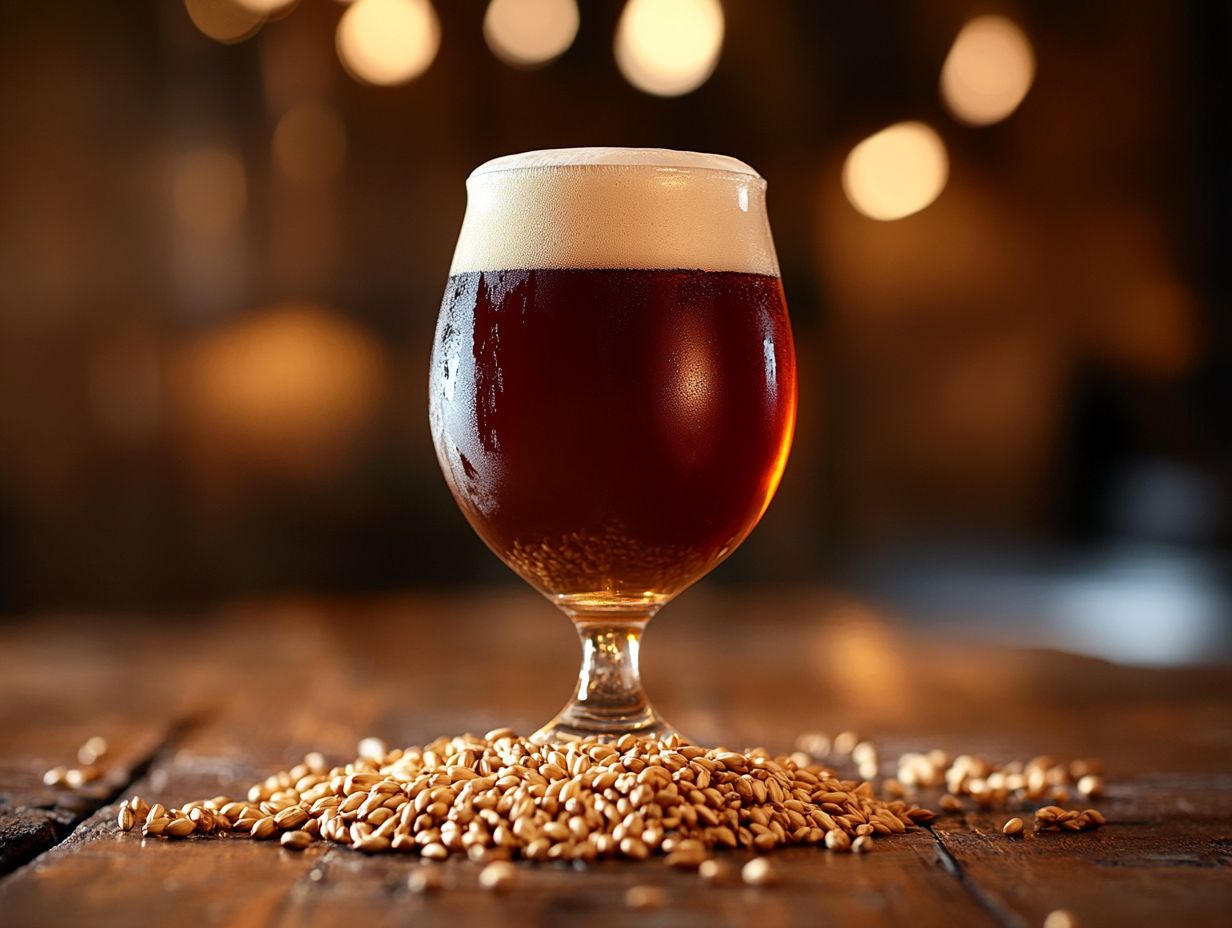
When enjoyed in moderation, barleywine may play a role in lowering cholesterol levels, thanks to certain polyphenols found in this distinctive beer. These polyphenols, including flavonoids and phenolic acids, boast antioxidant properties that enhance cardiovascular health by reducing oxidative stress and inflammation.
Research indicates that regularly consuming polyphenol-rich beverages like barleywine can positively influence cholesterol levels, potentially leading to a decrease in low-density lipoprotein (LDL) cholesterol, commonly known as ‘bad’ cholesterol. Additionally, these compounds may improve the health of blood vessels.
By incorporating moderate amounts of barleywine into a balanced diet, you can savor the deep, rich flavors of this unique brew while supporting your heart health.
5. May Improve Bone Health
The nutrients found in barleywine, particularly silicon, have been linked to improved bone health. This makes it a potential ally for supporting your skeletal integrity.
Along with silicon, barleywine also provides essential vitamins and minerals such as magnesium and phosphorus, which are crucial for maintaining bone density and strength. These nutrients work together to enhance the absorption of calcium, a vital component for robust bone structure.
When enjoyed in moderation, this rich and flavorful beverage can contribute to your overall wellness. It offers a unique source of antioxidants and promotes relaxation key factors in managing stress that can negatively impact bone health.
Therefore, incorporating barleywine into your balanced lifestyle may offer you more than just a delightful experience. It serves as a reminder of how mindful dietary choices can significantly affect your skeletal well-being.
How To Enjoy Barleywine?
To truly appreciate the rich complexity of barleywine, it s essential to understand how to enjoy it fully. Considerations include proper food pairings, optimal serving temperature, selecting the right glassware, and aging techniques that enhance its flavors and aromas.
This robust beer serves as a delightful companion to a wide array of dishes, from sumptuous meats to indulgent desserts, making it an incredibly versatile choice. It also finds a special place among other beverages like Moscato, IPA, White Zinfandel, and Grappa.
Serving it at the ideal temperature will elevate your tasting journey, while certain glassware can amplify its aroma, inviting you to savor every exquisite sip. Why not explore the flavors of barleywine today and see how it can elevate your dining experience?
1. Pairing With Food
Pairing barleywine with food can elevate your drinking experience. Its intricate flavors harmoniously complement a wide range of dishes, from rich stews to roasted meats, and even indulgent desserts like chocolate cake.
The robust malt character and natural sweetness of barleywine make it an exceptional match for equally bold flavors. For example, when enjoyed alongside a hearty beef brisket, the beer s sweet caramel taste goes well with the hearty flavor of the meat, creating a delightful contrast.
Cheeses, especially aged cheddar and blue cheese, also shine with this pairing; the sweet taste of barleywine perfectly balances the bold flavor of the cheese, making each bite an exciting experience! Desserts like pecan pie or cr me br l e become even more delightful companions to barleywine, as the beer s sweetness enhances the sugary elements of the dessert while leaving a warming finish that lingers on your palate. California Zinfandels are another example of beverages that pair wonderfully with rich, complex foods in a manner similar to barleywine.
2. Serving Temperature
The serving temperature of barleywine is essential to your tasting experience, with the ideal range falling between 50 F and 55 F. This temperature allows the beer’s rich flavors and aromas to blossom fully.
When you serve it at this optimal temperature, the complex notes of caramel, toffee, and dark fruit become strikingly pronounced, delivering a truly indulgent sensory experience. As the beer warms gently in your glass, delightful subtleties like hints of vanilla and spice begin to surface, enriching the overall depth of the brew. Barleywine is often featured in beer tastings and brewers’ favorite lists alongside other notable brews from Great Britain and beyond.
To reach this perfect temperature, consider chilling the barleywine for a short while, then letting it rest at room temperature for about 10-15 minutes before serving. This method tempers the alcohol warmth and preserves the beer s intricate flavor profile, transforming each sip into a captivating journey through its robust character. This is a common practice renowned by experts like Em Sauter and Don Tse.
3. Glassware
Choosing the right glassware for barleywine is crucial in the beverage world, as it can significantly enhance the beer’s aroma and elevate your overall drinking experience.
Consider options like tulip glasses or snifters, both of which come highly recommended.
These choices are not arbitrary; the shape and volume of your glassware play an integral role in releasing the complex fragrances that barleywines present, ranging from rich caramel notes to subtle hints of dark fruits, much like the way other beverages like IPA, White Zinfandel, and Moscato are enhanced by their glasses. For example, a tulip glass, with its slightly tapered top, concentrates delicate aromas, allowing each sip to become a more enjoyable experience. Conversely, a snifter s wider bowl encourages oxidation, which is when the beer interacts with air, bringing out deeper flavors in the drink, enhancing the beer s depth and warmth.
The differences in glass design can profoundly affect how flavors are perceived, underscoring the importance of selecting the right glassware to fully appreciate the richness of this robust style of ale. Choosing the right glass not only enhances the aroma but also maximizes your enjoyment of this rich beer.
Aging Barleywine
English Barleywine and American Barleywine are two styles that are particularly well-suited for aging.
Aging barleywine, particularly barrel-aged varieties, can greatly enhance their flavor profiles, allowing complex layers of sweetness and oxidative characteristics to unfold over time. This practice is championed by breweries such as Boundary Bay, Peticolas Brewing, and E9 Brewing.
This transformation leads to the emergence of rich notes of caramel, dried fruits, and subtle hints of vanilla or oak, all resulting from the interaction with the wood. Barrel aging is especially advantageous; it not only softens the initial alcohol bite but also imparts unique nuances absent in fresh brews. Similar to how Grappa and California Zinfandels improve with age, barleywines also develop richer profiles over time.
When considering which styles to age, traditional English and American barleywines truly excel under these conditions, thanks to their robust malt backbone. Well-respected breweries like Driftwood Brewing and Sierra Nevada have produced exceptional aged barleywines.
To maximize the aging potential, it s essential to store these bottles in a cool, dark place with stable temperatures, ideally between 50 F to 55 F. This way, you can ensure that the flavors evolve beautifully over the years.
Where To Find Barleywine?
Discovering quality barleywine can be a thrilling adventure for beer enthusiasts like you, with an abundance of choices waiting at local breweries, liquor stores, and online retailers. Don t miss out on the chance to taste incredible barleywines!
Many craft breweries take pride in their limited releases of barleywine, each offering a distinct interpretation and showcasing their unique brewing techniques. By exploring various sources, you gain access to a diverse selection while supporting local breweries that enhance the vibrant beer culture. Check out CraftBeer.com for recommendations and reviews from experts like Martyn Cornell.
1. Local Breweries
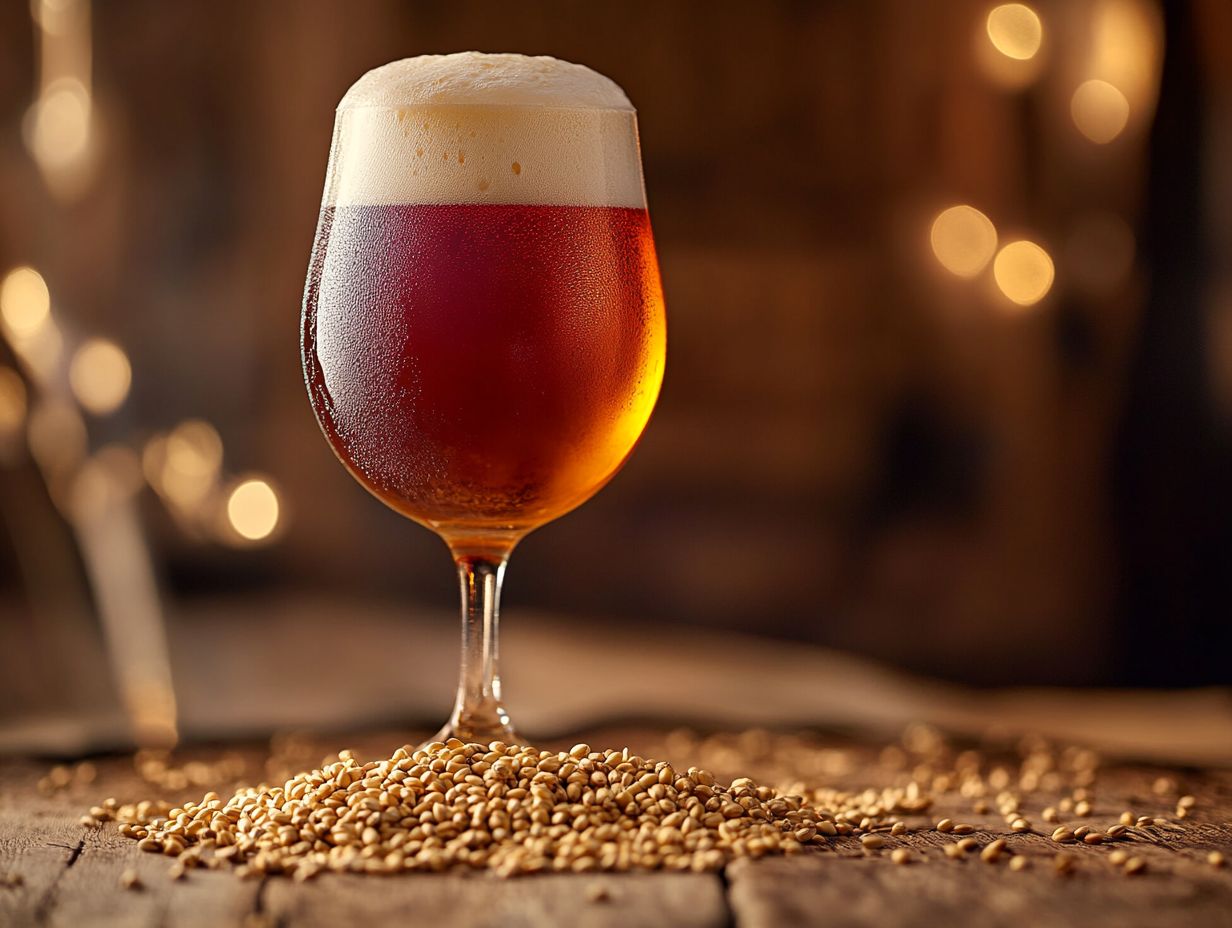
Local breweries, such as Great Britain’s Thomas Hardy s and Central City in A Coruna, are excellent places to discover unique barleywines.
These establishments provide some of the freshest and most unique selections of barleywine, crafting their interpretations of this robust beer style while fostering a direct connection to the brewing community.
By sourcing barleywine from nearby breweries, you enjoy exceptional quality and distinctive flavors, playing a vital role in supporting the local economy. You’re nurturing small businesses that infuse character into their brews. When you sample barleywine from renowned spots like Russian River Brewing Company in California or Founders Brewing Co. in Michigan, you’re indulging in the refined craftsmanship that defines these small-scale operations.
Locally brewed barleywines often showcase the region’s agricultural bounty, featuring ingredients sourced from nearby farms. This enriches the overall flavor profile and reinforces the vital connection between community and craft.
2. Liquor Stores
Liquor stores often offer an impressive selection of barleywines from various breweries, giving you the chance to explore different styles and brands all in one convenient location.
When hunting for a quality barleywine, seek out options that display distinct characteristics, such as a rich, malty profile harmoniously balanced by a subtle hop presence. It s also essential to check the alcohol content, as barleywines typically boast an ABV (Alcohol by Volume) ranging from 8% to 12%, providing insights into their strength and flavor intensity.
Be attentive to the packaging dates; opting for fresher choices can significantly enhance your tasting experience. Labels that highlight barrel aging or specific ingredients can offer further context, guiding you toward unique selections that align with your palate.
This thoughtful approach guarantees a rewarding exploration of this cherished beer style.
3. Online Retailers
Online retailers offer you a seamless way to explore a wide array of barleywine. You can find limited releases and elusive options from breweries nationwide.
This convenience is further enhanced by your ability to browse detailed product descriptions and read user reviews, empowering you to make informed choices.
Platforms like Total Wine, Craft Beer Kings, and BeerAdvocate not only present a diverse selection of barleywine, but also enable you to compare flavors, alcohol content, and pricing with ease.
This level of transparency fosters well-informed purchasing decisions, ensuring that your unique preferences are catered to.
Shopping from your home eliminates the hassle of visiting multiple local stores, saving you time and enriching your experience as you search for that perfect barleywine.
For more resources, check out CraftBeer.com and the works of renowned experts like Em Sauter and Don Tse.
Frequently Asked Questions
Why should I try a Barleywine?
Barleywine is a unique and flavorful beer style that offers a rich, complex taste experience for beer lovers. It’s a great way to expand your palate and try something new.
Renowned experts like Greywulfken often praise its depth and complexity.
What makes Barleywine different from other beer styles?
Barleywine is typically a stronger and more full-bodied beer than other styles, with a higher alcohol content and a taste that emphasizes malt. Its name comes from the use of barley as the primary grain in the brewing process.
Is Barleywine only for those who enjoy strong beers?
No, Barleywine is not just for those who prefer strong beers. While it does have a higher alcohol content, there are different variations and styles of Barleywine that offer a range of flavors and intensities.
From the lighter notes of an English Barleywine to the robust intensity of an American Barleywine, there’s a Barleywine for every palate.
What food pairs well with Barleywine?
Barleywine pairs beautifully with savory, hearty dishes that enhance its rich flavors, such as roasted meats, stews, and strong cheeses.
The maltiness and richness of the beer complements and balances out the flavors of these foods. Consider pairing it with a robust meal much like you would with California Zinfandels.
What is the best way to serve Barleywine?
Barleywine is best served in a round glass that helps enhance its aroma and flavor. It should be served at a slightly warmer temperature than other beers, around 50-55 degrees Fahrenheit, to allow the flavors to fully develop.
Are there any health benefits to drinking Barleywine?
In moderation, Barleywine can offer some health benefits due to its high levels of antioxidants and nutrients from the barley.
However, it is important to always drink responsibly and consult a healthcare professional with any questions. Noted on platforms like CraftBeer.com, it s advisable to explore the benefits and enjoy in moderation.
Don t miss out on the chance to explore the unique flavors of Barleywine responsibly!

